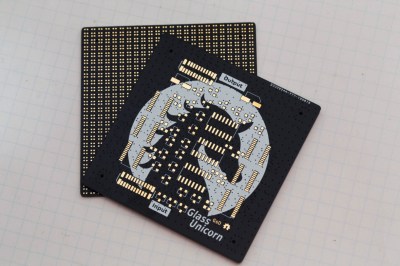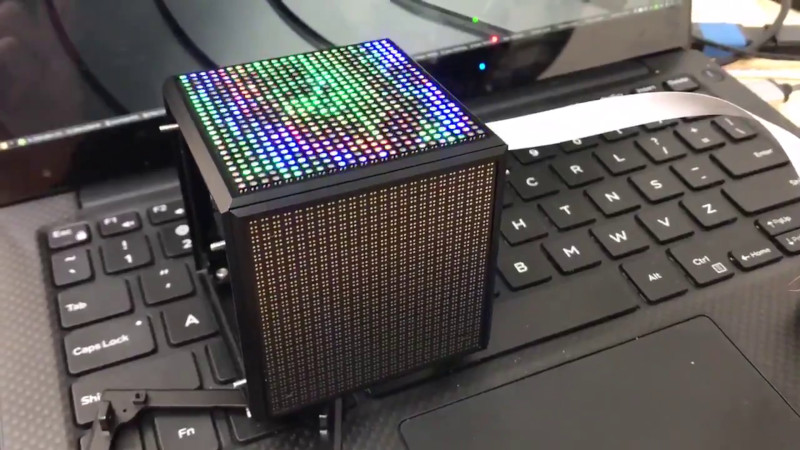We see all kinds of projects come across the news desk at Hackaday. Sometimes it’s a bodge, neatly executed, that makes us laugh out loud at its simple ingenuity. Other times, it’s a case of great skill and attention to detail, brought to bear to craft something of great beauty. [Greg Davill]’s LED cube is firmly the latter.

The build starts with custom four layer PCBs, in matte black with gold-plated pads. It’s a classic color scheme, and sets the bar for the rest of the project. Rather than proceeding to hook up some commodity microcontrollers to off-the-shelf panels, [Greg] goes his own way. Each PCB gets a 24×24 raw LED matrix, directly soldered on the back side. By producing a “dumb” matrix, there are large savings in current draw to be had over the now-popular smart strings.
The panels are then loaded into a tidy 3D printed cube, with space inside for the FPGA running the show and a power supply. Five panels are held in with double sided-tape and screws, with the last being installed with magnets to allow access to the inside. Neatly folded flat-flex cables are pressed into service to connect everything up.
It’s a build that shows there is value in doing things your own way, and that the new methods don’t always beat out the old. With careful consideration of aesthetics from the start to the end of the project, [Greg] has built an LED cube both astounding in its simplicity, and beautiful in its execution. We’ve seen [Greg]’s work before, too – it’s not too often hand soldered BGAs cross these pages. Video after the break.
— Greg (@GregDavill) September 2, 2019















Interesting keyboard in the background…
Thats the standard keyboard on a Dell XPS, right ?
Monitor shows Linux Mint wallpaper.
I think it’s more the key placement he’s referring to, I don’t recognize the key mapping, but I did think, for some reason Greg is in South Africa?
Looks like a Dvorak layout
seems he changed his layout to the Dvorak Layout :)
The case is not 3D printed, it is CNC aluminium.
I will admit that I thought this was a classic HaD double post but looked closer when I noticed that is was the same author for both this and https://hackaday.com/2019/09/05/this-led-cube-is-one-heck-of-an-icebreaker/
So Lewin, what had you been searching for to find these two attractive LED cubes? is there some forum that these people hang out on?
Hmm, they both happen to use the Latice iCE40 FPGA (albeit at different resolutions)
Everybody loves shiny LEDs…
This one is a cracking job from scratch though!
This is all twitter is about (for me) these days! All the iceBreaker news, and now, it’s awash with LED cubes.
Makes for very pretty scrolling through the tweets, anyway!
“By producing a “dumb” matrix, there are large savings in current draw to be had over the now-popular smart strings.”
…sacrificing brightness. You could just set the off-shelf module brightness lower for the same result
in exchange for color depth
Don’t forget the quiescent current draw of “smart” panels (anything with pixel-level drivers), and even the HUB75 based stuff have a significant “off state” draw.
“Handmade” has undergone a massive inflation lately.
All the parts are outsourced or made by machine. There’s no “craft” here, just tab A fits slot B.
Can a carpenter who made his own bookcase call it handmade? He also outsourced all the parts(wood, fasteners) and used machines to make it, be it human-powered machines like a handsaw or screwdriver, or power-tools.
You could describe it as “It’s just buying the wood and putting the screws in, no big deal”, but if you tried to make a bookcase you would quickly realize there’s more to it.
I think this is as handmade as it becomes
I’d say the word loses more meaning as more of the product’s construction involves machines.
What’s the difference between a carpenter using a CNC machine to make a bookshelf versus an Ikea build? Is the former “handmade” because he drew up the design? What if he just downloaded the design from someone else?
If the carpenter can’t make the machine he’s using, but relies on its capabilities, it’s that much less a handmade object. If the carpenter made the machine by hand, then the end product is that much more handmade.
Um, you should probably look at the rest of his twitter thread, for example this tweet and the one after it: https://twitter.com/GregDavill/status/1166683436381159425
Lol, Greg literally hand populated each part on those PCBs, after designing them himself.
Greg actually is one of the few people insane enough to hand-build a lot of what he designs, which is insane, given the complexity of the designs, and the self-loathing of his component package choices ;)